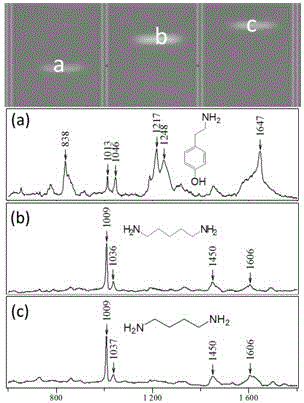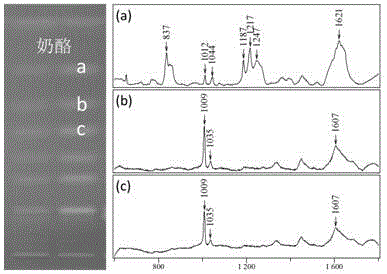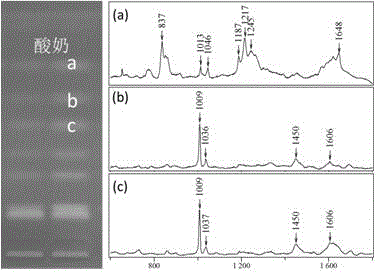Method for rapidly detecting multiple biogenic amines in dairy product by virtue of combination of high performance thin layer chromatography and adjustable surface enhanced raman spectroscopy
A high-efficiency thin-layer chromatography and surface-enhanced Raman technology, which is applied in the direction of measuring devices, instruments, scientific instruments, etc., can solve problems such as difficult to distinguish chromatographic separation results, and achieve the effect of broadening the scope of application
- Summary
- Abstract
- Description
- Claims
- Application Information
AI Technical Summary
Problems solved by technology
Method used
Image
Examples
Embodiment 1
[0021] (1) Preparation of nano-silver colloid: take 5 mL of commercially available nano-silver particle suspension (Aladdin Reagent Company) and centrifuge at 4000r / min for 10 min, discard 4.5 mL of supernatant, and place the remaining 0.5 mL of liquid in a mixing chamber Vibrate fully on the device for 1min to resuspend to obtain 10 times concentrated nano-silver colloid;
[0022] (2) Preparation of standard solutions of biogenic amines: use methanol as solvent to prepare standard solutions of tyramine, cadaverine and putrescine with a concentration of 0.05 mg / mL;
[0023] (3) High-efficiency thin-layer chromatographic separation: use a thin-layer chromatography spotting instrument to accurately spot the 2-4 μL standard solution of biogenic amines prepared in step (2). After the spotting is completed, develop with a developing solution, and develop up to 50 mm to take out the silica gel plate; derivatized by dipping with 0.1 mg / mL fluorescamine in acetone solution, removed th...
Embodiment 2
[0027] Weigh 10g of cheese sample, add 10mL of 10% trichloroacetic acid aqueous solution and mix it into a homogenate with a homogenizer. Add 0.1mL 0.25g / mL NaOH solution to the homogenate, shake and mix well, place it in a centrifuge at 3000r / min for 5min, take 2mL supernatant, and filter it with a 0.45 μm fiber membrane to get rid of the main matrix interference cheese samples.
[0028] Using 0.5 MPa nitrogen gas as the carrier, use a 100 μL syringe (CAMAG) to accurately spot 2-4 μL of each cheese sample and biogenic amine standard on a 10×10 cm thin-layer plate with Linomat 5, and the spotted strips 6mm long, the strips are 8mm from the bottom, 12mm from the left end, and the strips are spaced 1.7mm apart. After sample pointing, use the ADC-2 (CAMAG) developing instrument to develop. Before developing, inject 10 mL of mobile phase into another tank to make the cylinder reach a saturated state. Take 10 mL of the optimized developing solution (methanol / acetone / ammonia water...
Embodiment 3
[0032] Weigh 10g of yogurt, add 10mL of 10% trichloroacetic acid aqueous solution and mix it into a homogenate with a homogenizer. Add 0.1mL of 0.25g / mL NaOH solution to the homogenate, shake and mix well, place it in a centrifuge at 3000r / min for 5min, take 2mL of the supernatant, and filter it with a 0.45 μm fiber membrane to get rid of the main matrix interference yogurt samples.
[0033]Using 0.5 MPa nitrogen gas as the carrier, use a 100 μL syringe (CAMAG) to accurately spot 2-4 μL of each yogurt sample and biogenic amine standard on a 10×10 cm thin-layer plate with Linomat 5. The strip length is 6mm, the strip is 8mm from the bottom, 12mm from the left end, and the strip spacing is 1.7mm. After sample pointing, use the ADC-2 (CAMAG) developing instrument to develop. Before developing, inject 10 mL of mobile phase into another tank to make the cylinder reach a saturated state. Take 10 mL of developing solution (methanol / acetone / ammonia water (25%)=3 / 7 / 0.5 (v / v)), develo...
PUM
 Login to View More
Login to View More Abstract
Description
Claims
Application Information
 Login to View More
Login to View More - R&D
- Intellectual Property
- Life Sciences
- Materials
- Tech Scout
- Unparalleled Data Quality
- Higher Quality Content
- 60% Fewer Hallucinations
Browse by: Latest US Patents, China's latest patents, Technical Efficacy Thesaurus, Application Domain, Technology Topic, Popular Technical Reports.
© 2025 PatSnap. All rights reserved.Legal|Privacy policy|Modern Slavery Act Transparency Statement|Sitemap|About US| Contact US: help@patsnap.com



